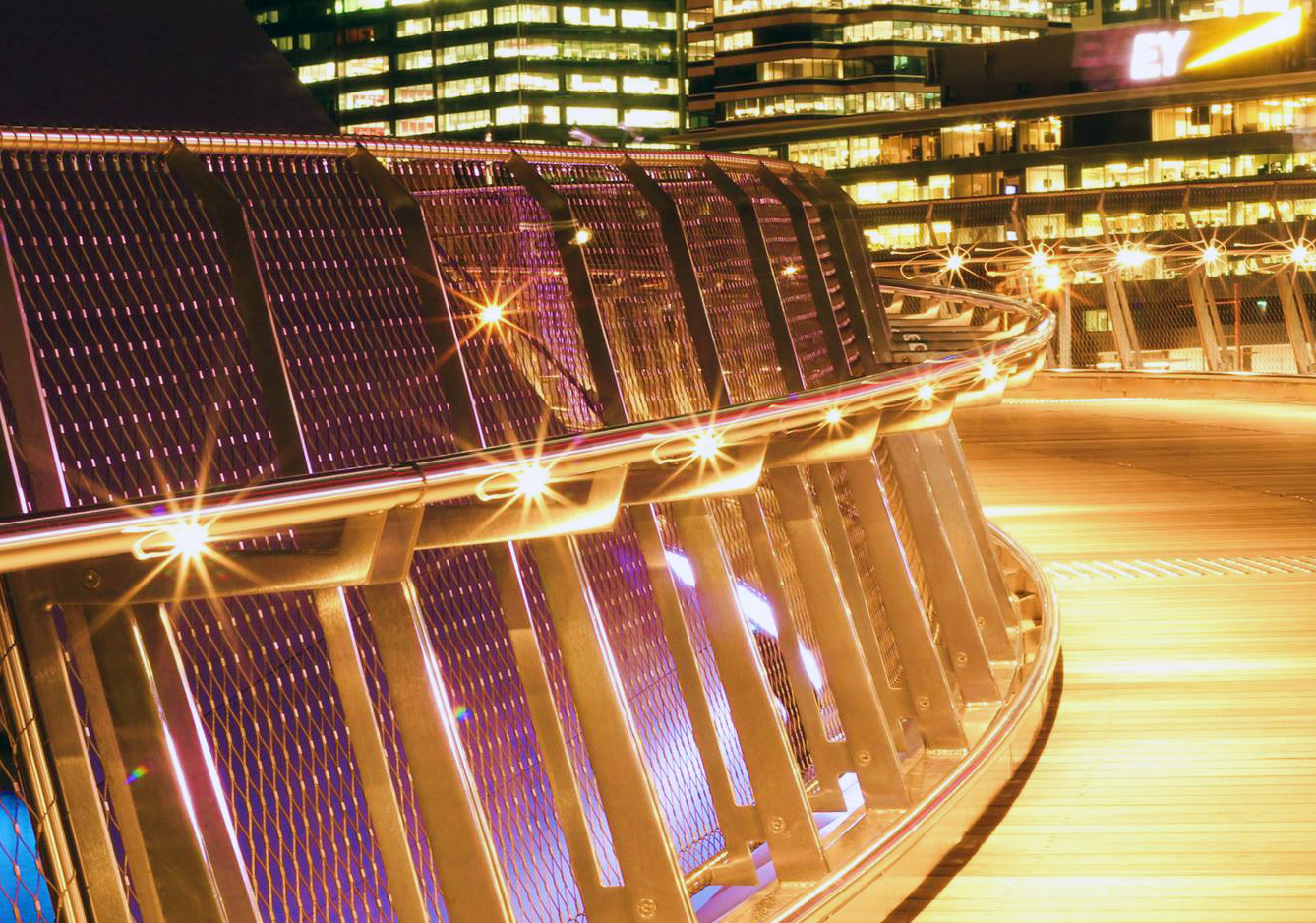
The successful collaboration of ASSDA members and their expertise in the extensive use of stainless steel has been integral to bringing Perth’s iconic and most complex bridge to life.
The Elizabeth Quay Pedestrian Bridge was constructed by DASSH, a joint venture between Decmil, Structural Systems and Hawkins Civil, and is a key feature of the Elizabeth Quay mixed-use development project core to revitalising Perth’s CBD.
Designed and engineered by Arup, the cable-stayed suspension bridge features a leaning double arch, is 22m high, 5m wide and is suspended over the inlet of the Swan River with a clearance of 5.2m from the water. The 110m long meandering pedestrian and cyclist bridge allows for continuous movement around the Quay, connecting the new promenades, an island and ferry terminal.
Stainless steel reinforcement plays a vital structural role in the bridge, with ASSDA Sponsor Valbruna Australia supplying approximately 89 tonnes of 2304 grade Reval® in 12, 20, 25 and 32mm reinforcement bar for the three concrete river piers. The reinforcement bar diameters originally specified were not available locally and so the design was modified to accommodate what was ex-stock in Australia to minimise construction downtime.
Installed exclusively in the splash zones of the concrete piers, stainless steel reinforcement was specified to resist corrosion attack and prevent concrete spalling. In addition, the overall mass of the concrete piers had to be minimised in order to support and achieve the sleek, sinuous design of the almost 200 tonne arches.
Reduction in concrete mass decreases the overall protection of the installed reinforcement bar, resulting in stainless steel as the material of choice to achieve the slimmer river piers and meet the demands of the architectural design.
During the grade selection process, grade 2304 lean duplex stainless steel was also deemed the most cost effective option to reduce ongoing maintenance costs and deliver the expected 100-year service life of the structure.
Visually, stainless steel is also featured in the key design elements of the bridge, including the handrails, balustrades, support posts, mesh barriers, kerbing, fascia panels and kick rail stations. Local jarrah timber decking and decorative feature lighting was used to complete the durable and low-maintenance walk and cycle way.
ASSDA Member Stirlings Australia supplied over 60 tonnes of stainless steel for the bridge project, including 111 wire mesh panels, over 300m of 50.8mm x 3mm round tube in a 320 grit finish to support the mesh panels, welded pipe for the handrails and balustrades, and 2205 and 316/316L grade plate in 6mm and 10mm. An additional 52 tonnes of 316/316L and 8 tonnes of 2205 grade stainless steel plate was supplied and laser cut in-house by Stirlings Australia using their 6000mm x 2000mm laser cutting machine for large-format materials.
Furthermore, Stirlings Australia supplied 7 tonnes of stainless steel channel and angle bar for the architectural elements and structural sections of the quay’s new ferry terminal.
ASSDA Sponsor Vulcan Stainless also supplied the project with over 50 tonnes of laser cut 2205, 316 and 316L grade stainless steel. Polished 2205 grade 3mm stainless steel plate was supplied via its Sydney service centre, cutting approximately 10 tonnes of coil to length, which was then laser cut to size and polished to the specified No. 4 finish prior to delivery. Upright and support pieces for the balustrading were also laser cut and supplied from Vulcan Stainless’ Sydney and Perth service centres using 316 grade 12mm and 316L grade 16mm stainless steel plate.
The 25mm thick pieces were cut using Vulcan Stainless’ in-house 8kw Trumpf Laser, the only machine in Western Australia able to laser cut at this thickness including holes.
Both Stirlings Australia and Vulcan Stainless also supplied laser cut 316/316L grade stainless steel plate for the planter beds that formed part of the landscaping around the Elizabeth Quay precinct.
ASSDA Member Unifab Welding was contracted to fabricate and install over 60 tonnes of stainless steel for the visual elements of the pedestrian bridge as supplied by Stirlings Australia and Vulcan Stainless.
Over 60 different individual balustrade sections each at 1800mm tall were fabricated to allow for the shape and movement of the bridge. Manufactured in compliance with AS/NZS 3992 and ASME 9, Unifab Welding used gas manual arc welding (GMAW) and gas tungsten arc welding (GTAW) techniques to fabricate the various sections.
To meet strict deadlines, all kerbing pieces were welded together using 8mm stainless steel flat bar to replicate the originally specified 300x100x8mm rectangular hollow sections (RHS), a product that was not locally available off-the-shelf. The kerbing pieces were also polished back to a 320 grit and No. 4 finish.
Aside from the wire mesh, all stainless steel components for the bridge were polished to Ra<0.5 and then electropolished prior to installation to provide maximum corrosion resistance in the salt-water environment.
A key architectural feature of Elizabeth Quay, the pedestrian footbridge was opened to the public in January 2016. It exudes in quality, aesthetic appeal and durability with its extensive use of stainless steel, and is certain to provide the structural and material performance required to stand the test of time.
Offering 360-degree views, the bridge is an exciting addition to Perth’s CBD and provides increased opportunity for locals and tourists to interact with the Swan River and reinvigorated waterfront destination.
This article in Australian Stainless Magazine Issue 58 (Summer 2016/17).